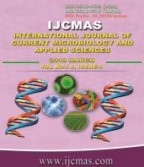


 National Academy of Agricultural Sciences (NAAS)
National Academy of Agricultural Sciences (NAAS)

|
PRINT ISSN : 2319-7692
Online ISSN : 2319-7706 Issues : 12 per year Publisher : Excellent Publishers Email : editorijcmas@gmail.com / submit@ijcmas.com Editor-in-chief: Dr.M.Prakash Index Copernicus ICV 2018: 95.39 NAAS RATING 2020: 5.38 |
Lentil (Lens culinaris) is affected by the wilt disease caused by fungal pathogen Fusarium oxysporum f.sp. lentis at seedling stage and at the later stages of growth. The pathogen is soil and seed borne in nature and reported from all lentil growing areas. The present investigation is on the management of the lentil wilt pathogen by exploiting the resistance mechanism of the host. Ninety two germplasms were screened along with the local check (Sehore) under field conditions during the two consecutive years 2016-17 and 2017-18. The reactions of the host against the pathogen were recorded in the wilt sick plot by calculating the per cent of number of infected plants over total plants observed. The germplasms were further categorized into Immune (0 germplasm), Highly Resistant (11 germplasm), Resistant (13 germplams), Moderately Resistant (18 germplams), Susceptible (40 germplams) and Highly Susceptible (10 germplams) depending on the disease reaction. Wilt incidence was varied from 0.33 percent to 96.67 percent during the year 2016-17 and 0.75 percent to 93.56 percent during the year 2017-18. None of the screened germplams was found immune against the disease. Eleven germplasms viz., DL16-5, DL16-7, VL152, IPL339, IPL340, PL237, RL7-3, RVL15-5, IPL227, IPL338 and IPL332 were found highly resistant to the disease under the field conditions. The present investigation suggests that the resistance in the lentil germplasms can be exploited for the management of the seed and soil borne pathogens and is an effective management practice with less use of inputs.
 |
 |
 |
 |
 |